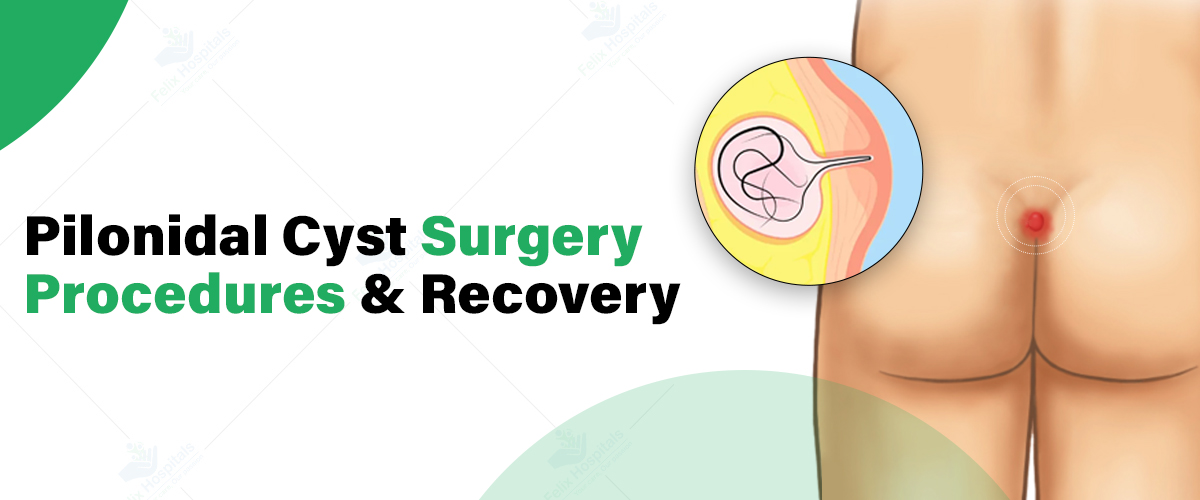
Subscribe to our

A pilonidal cyst is a condition characterized by a cyst or abscess located near the tailbone, often containing hair, skin cells, and other debris. This condition commonly affects young adults and can cause significant discomfort and pain. If conservative treatments are ineffective, surgical intervention may be required. Let’s explore the various surgical procedures for treating pilonidal cysts and the recovery process, emphasizing the importance of selecting a best proctology hospital in Noida to ensure the best possible treatment outcomes.
Don't let a pilonidal cyst disrupt your daily life. Book Your Appointment Now - +91 9667064100.
Pilonidal cysts develop in the natal cleft, the area between the buttocks, where they can become infected and inflamed. The exact cause of pilonidal cysts is not fully understood, but factors such as hair growth, friction, and prolonged sitting are believed to contribute to their formation. Symptoms typically include pain, swelling, redness, and discharge from the affected area.
1. Incision and Drainage:
2. Excision with Primary Closure:
3. Excision with Flap Closure:
4. Laser Surgery:
1. Immediate Post-Operative Care:
2. Activity Restrictions:
3. Follow-Up Appointments:
4. Complications to Watch For:
5. Long-Term Care:
Dr. Ritesh Agarwal is an expert in a wide range of open and laparoscopic general surgeries, including laparoscopic cholecystectomy (gallbladder stone removal), Hernia Repair, and laparotomy. He also specializes in non-cancerous breast surgeries, such as breast lump removal, treatment for breast pain, and management of nipple discharge. As a trained laser surgeon, Dr. Ritesh performs advanced proctology surgeries, including treatments for Piles, fissures, fistulas, pilonidal sinus, varicose veins, and circumcision. His extensive experience and skill make him a trusted specialist in these areas.
Take the first step towards a pain-free life. Consult with a Proctology Specialist Today call us on - +91 9667064100.
Pilonidal cyst surgery is a proven method to address painful and recurrent cysts. By understanding the various surgical options and the recovery process, patients can make informed decisions and prepare for a successful outcome. Adherence to post-operative care instructions and follow-up appointments plays a vital role in ensuring a smooth recovery and minimizing the risk of complications. For personalized advice and to explore your surgical options, consult with the Best Laparoscopic Surgeon in Noida who can provide expert guidance tailored to your specific needs.
1-What is the main cause of pilonidal cysts?
The main cause of pilonidal cysts is often attributed to ingrown hairs. When hair penetrates the skin, it can lead to inflammation and the formation of a cyst or abscess. Other contributing factors include prolonged sitting, friction, sweating, and wearing tight clothing, which can irritate the skin in the tailbone area.
2-Do pilonidal cysts go away?
Pilonidal cysts do not typically go away on their own. In some cases, the cyst may reduce in size or temporarily stop causing symptoms, but it often remains present and can flare up again, especially if left untreated.
3-Can a pilonidal cyst heal naturally?
A pilonidal cyst is unlikely to heal naturally without medical intervention. While some mild cases may drain and temporarily resolve, most cysts require treatment, such as incision and drainage or surgery, to fully heal and prevent recurrence.
4-Is it safe to live with a pilonidal cyst?
Living with an untreated pilonidal cyst can be uncomfortable and poses risks of infection, abscess formation, and recurrent flare-ups. It’s advisable to seek medical attention to avoid complications and ensure proper treatment.
5-Can a pilonidal cyst become cancerous?
While extremely rare, there is a small possibility that a chronic or long-standing pilonidal cyst could develop into a type of skin cancer called squamous cell carcinoma. However, this is uncommon, and most pilonidal cysts do not become cancerous.
6-Is pilonidal cyst normal?
Pilonidal cysts are relatively common, particularly in young adults, and especially males. While they can cause discomfort and require treatment, they are considered a manageable medical condition.
7-What ointment is good for pilonidal cyst?
Over-the-counter antibiotic ointments like Neosporin or antiseptic creams can be used to reduce the risk of infection in minor cases. However, it’s important to consult a healthcare professional for appropriate treatment and advice.
8-How to sleep when you have a pilonidal cyst?
When you have a pilonidal cyst, it's best to avoid sleeping on your back to reduce pressure on the affected area. Try sleeping on your side or stomach to minimize discomfort and prevent aggravating the cyst. Using a special cushion or a donut-shaped pillow can also help alleviate pressure while sitting or sleeping.